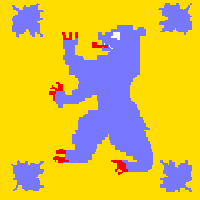The bulk of this post is not my writing, but that of David Helber of the
Major General Tremorden Rederring's Colonial-era Wargames Page; which a great many of us feel is perhaps the single best table top gaming site for Colonial gaming.
I freely admit that I am stealing his text about "size" because I think that it is a very important concept. I hope that he understands that I make no claim that the following comments are mine, they are not . . . but I fully endorse what he wrote over a decade ago.

The photo to the left, by the way, is from one of my very first Colonial games. We were using "The Sword and the Flame" rules and all figures are "true 25mm" Ral Parthas.
(as always, click on photos for much larger image.)
The Governor General's daughter, Pauline (in blue) has once again wandered off and managed to get herself into "a spot of bother". Troops were sent out to rescue her. They failed, as I recall.
Playing surface is ordinary brown wrapping paper, crinkled up, then smoothed out, palm trees in the background were from a "cake decoration supply company" and the white blocks are mah jong tiles.
The photo below shows some of my simple "Arab Buildings" (built according to the excellent instructions on the
Major General's Building Construction Page) . . . and as the figures are mounted on pennies (about 19mm), you can see some of the "Small is Beautiful" philosophy at work.
-- Jeff
*****
Small is Beautiful
Contrary to what your significant other might tell you, size matters -- especially in tabletop gaming.
Specifically: small is beautiful. Because table space is always so limited, everything used in a game must be as small as it can be and still do its job.
The Ouargistan group uses a 5/8"=15mm (David's preference) or 3/4"=19mm (everybody else's) base size for 25mm military figures where possible, with the occasional base cut larger to accomodate the odd figure that needs it.
Even a 1" base means that a unit of men will take up over 30% more linear space on the table and 90% more area than those on a 3/4" base. A 2-rank unit of 20 men will be 10" wide, rather than than 7.5". Ten inches is a lot on a table which is only 48" across.
When the gaming includes buildings, boats, or vehicles, base size is even more important. Even though we allow bases to overlap when figures are in a boat or structure, a base which is even slightly larger will substantially reduce the number of men which can fit in the same space.
 A rooftop which is 2.25" square will take nine men with 3/4" bases, but only four men with 1" bases.
A rooftop which is 2.25" square will take nine men with 3/4" bases, but only four men with 1" bases.
Buildings and vehicles themselves should be as small as they can be without looking completely ridiculous.
In Ouargistan, a small, flat-roofed native building will be as small as 2.25" square with a roof 1.5" off the ground. The difference between a 2.5" and a 3.5" building doesn't sound like much, but it will allow you to put a 5-building town in about the same space as a 3 building town with the larger size.
When building structures and vehicles it is very easy to let size get out of hand. You must exercise ruthless care to keep things to a minimum, or else you wind up with forts or villages that take up half the table, and boats which require so much river to maneuver that there is no room for land.
Generally our native buildings run from about 2.25" square to about 3"x 5", forts are about 12" square, and the largest boats/ships are no more than 9" long.
-- Copyright©1998 David Helber
 I have played a couple of versions of "The Sword and the Flame" (generally abreviated as TSATF) and "G.A.S.L.I.G.H.T.", both of which I enjoyed. But I also found things with each that I wanted to change.
I have played a couple of versions of "The Sword and the Flame" (generally abreviated as TSATF) and "G.A.S.L.I.G.H.T.", both of which I enjoyed. But I also found things with each that I wanted to change.


